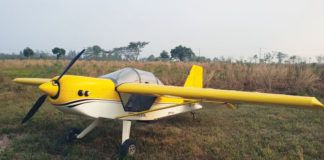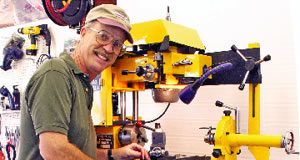On a Lighter Note…
Hopefully you can help me out with a solution to my problem. I have an electronic sign that used to mount to an airplane. Its a scrolling sign, much like you see in a store window with all the LED bulbs, except its 30 feet by 8 feet. It operates with a 12-volt power supply. My problem is the electronics part of it is missing and the manufacturer no longer exists, so other than supplying the sign with power and checking if the lights work, there is no way to control the sign. Heres my question: I have a small electronic sign that operates LEDs, it has the same configuration (seven lights high) and I have taken it apart to isolate each light as it flashes. In theory, I could link each LED to each bulb on the larger sign to trigger when it is supposed to, therefore giving me a way to operate the sign, but obviously there’s not enough power sent to the large sign when wiring it to the small sign. I did link a couple of the LEDs to the 12-volt bulbs the large sign uses and it operates as expected, just dim. Is there a way to boost the power of the large sign while still having it controlled by the small sign? Hopefully you’ll have the time to advise. Thank you for your time. (I got your information from KITPLANES magazine.)
Andy Mackey
Jim Weir responds: “The answer to your question is that anything can be done. Generally the question is whether or not the result is worth the trouble. The first comment is that if I asked an engine maven whether or not I could get half again more power out of my aircraft engine, the answer would be most certainly. The problem, of course, is that (s)he would probably be able to do a lot of the calculations from experience and education, while trying to tell me how to do it would involve a lot of time and some of the small stuff that just comes naturally with years of doing it might be overlooked in the education process. Simply telling me to bore my cylinders oversize isn’t doing me much good unless I know off the top of my head what the allowable oversizes are or where to look them up. And, if I knew where to look them up, I probably wouldn’t have to be told to bore them out.
Catch 22. Ill give you a pointer. Your large bulbs need more current. Without the sign and controller in my hands, Im necessarily going to have to be vague about how to get it. Google common collector and note that any small current injected into the base of an NPN bipolar transistor will be amplified by the current gain (beta) of the transistor and be available at the emitter to do the work. If the small current available from your controller is injected into the base, the emitter should be capable of driving the large lamp. Your problem is to figure out what voltage/current the large lamp requires and design the transistor stage accordingly.
“Where Did He Go?
I appreciated Len Buckwalters article [on TSO requirements for transponders and encoders], but I wanted to point out a significant historical error in the story he laid out regarding the 1956 collision. The aircraft were same direction, had almost zero rate of closure and were not receiving radar services at all. The TWA aircraft was VFR-on-top, and either the crews were not looking outside enough (canyon vista excluded) or the TWA crew blew off the cloud clearance requirements. This accident resulted in the creation of Positive Control Airspace (now Class A) and ended VFR-on-top clearances above FL180.
Anthony Turiano
ATP/CFI/A&P/Air Traffic Controller
IFR and the Incredible
Shrinking Magazine
I get six magazines by subscription. Your KITPLANES is one of them. I have been in aviation almost 54 years. I built and fly a SeaRey as an LSA in Florida. This email is to let KITPLANES know that come August 2008 my subscription will not be renewed. The reason being that the days of five- to six-dollar magazines are over in this hangar. Have you noticed that the magazines are getting thinner, cost more and contain more advertisements? As for articles in the October 2007 issue, please remind the electronic gilhooley geeks that its still a see and be seen world below 10,000 feet. Stop pushing those buttons and get your eyes out of the cockpit. Also, talking about IFR in a KITPLANES magazine is an oxymoron! Granted, GPS does give situational awareness. Last time I was involved, IFR was a proficiency thing. As you can tell, Im not a fan of single pilot, single engine IFR flying, and neither should KITPLANES be.
Frank Gracy
First, this magazine hasnt shrunk or become more expensive in years. Compare us to the cost of gas or a cup of coffee at Starbucks. Second, well have to agree to disagree about flying IFR in some Experimentals. Obviously, there’s a segment that, for reasons of intent, aerodynamics, ability to carry equipment and handling qualities should remain VFR-only aircraft. But there are a good many designs that make fine, legal IFR aircraft. For some perspective, though, understand were not talking about all-weather, Boeing 767-style IFR. Know your limits. Regardless, we receive many questions about IFR equipment and legalities for homebuilts, and those of us who use our Experimentals for travel generally prefer the flexibility to file IFR if necessary to complete the trip over the risks of scud running.-Ed.




